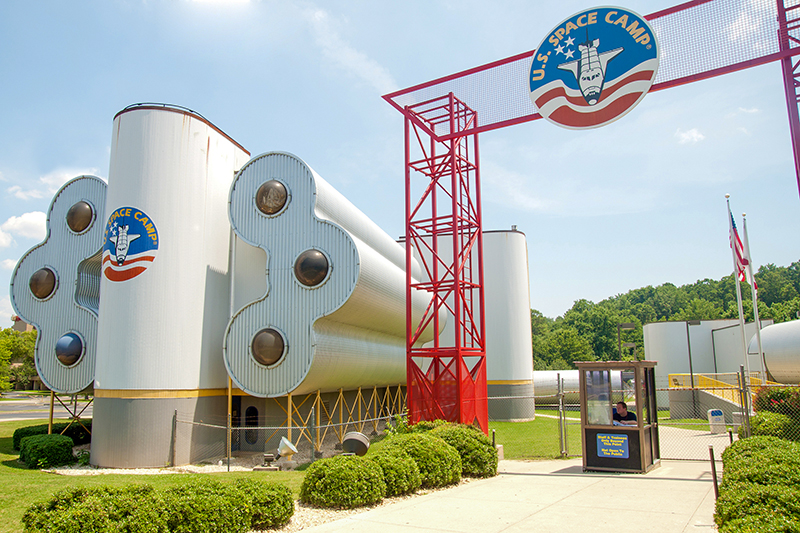To the Moon and Back on 4KB of Memory
Forty-five years ago, NASA traveled to the moon with far less power than an iPhone.

Consider, if you will, the device that’s more than likely sitting in your pocket or bag. Whether a smartphone or tablet, it’s a wondrous testament to the progress of humanity’s technological advances. That thin, metal, glass and plastic slab — regardless of who made it and what it runs — contains everything we hold essential to daily lives within its slender frame. It connects us to any part of the world, enables instant communication, delivers photos and videos, and lets us while away free time on dubiously addictive games.
There’s an image that regularly makes the rounds on social media, one from the ’80s, which features a man surrounded by technology of the day — a video camera, a boombox, a Walkman, a Betamax player, a calculator and so forth. A common caption attached to the photo is that now, all of the devices the man has can fit into our pockets. That’s a pretty mind-blowing fact when you really think about it. However, it’s not even close to an awe-inspiring comparison with a much older, much grander technological achievement.
This past week, America — and, indeed, the world — celebrated 45 years since NASA successfully put the first men on the moon. On July 20, 1969, Neil Armstrong and Buzz Aldrin, with Michael Collins monitoring from above, took humanity’s first steps on another world. It was, as Armstrong told the world watching at home, “one giant leap for mankind.” It was also, reflecting on the events from a modern perspective, something of a miracle.
The ’60s were marked by a leap in technological capabilities. Previous computers and electronic circuits relied on vacuum tubes to process their information, but the ’60s brought the mass production of the staple of all modern electronics: the transistor. The transistor enabled smaller, more efficient computers and processing devices, which in turn led to the creation of the integrated circuit — more commonly known as the microchip. Of course, the development of the microchip and fast adoption of the transistor would likely have been much slower had it not been for one organization: NASA.
NASA’s space race with the Soviet Union was, by this point, culminating towards one objective: getting a man on the moon. The Soviets had succeeded in putting the first human in space, with Yuri Gagarin, and America wasn’t going to let them grab the next major milestone. The Apollo program would be NASA’s magnum opus, an achievement unrivalled to that point. However, it also demanded a serious amount of computational power. From NASA’s mission control, to the rocket’s power systems, to the command module’s guidance computer and the lunar lander’s control scheme, everything demanded new, original software and technology to help NASA achieve their goal.
IBM was drafted to provide NASA’s vast mainframes, with over 3,500 IBM employees working with the agency to install IBM’s established System/360 mainframe computers at the Goddard Space Flight Center and NASA’s Manned Spacecraft Center in Houston. The computers handled every part of the Apollo 11 mission, letting NASA communicate across their various bases and with the spacecraft itself. Aldrin and Armstrong used the computers at Houston to determine their lift-off from the surface of the moon and approximate their rendezvous with Collins in the command module. At the time, the program written by IBM for NASA’s systems was the most complex computer software in existence.

The command module, which housed the astronauts as they rocketed to the moon and would return them safely again, was also filled with new technology. The Apollo Guidance Computer directing the rocket was an incredible achievement for NASA — it was the first computer system to provide real-time information about the spacecraft as it navigated, detailing important stats and allowing for automatic navigation. It was also the first example of an integrated circuit — NASA is credited with helping the microchip come into existence. It was sophisticated, operated by inputting words and numbers on a calculator-style keyboard, and featured multitasking and an error-reporting system. It was also a necessity, as only a computer was able to provide the accurate control the spacecraft required in order to successfully navigate to and from the Earth. Manual control was certainly possible, but only a computer could guarantee a success — and even then it wasn’t a safe bet.
What’s most impressive, though, is that NASA launched a rocket into space, guided three astronauts to the moon, landed two of them on its surface, returned them to their original craft and brought them home again with less computational power than you’ve got in your iPhone. A lot less. IBM’s mainframes, at their fastest, couldn’t rival a store-bought USB stick today for computational prowess. The command module in the spacecraft? Your car is infinitely more complex.
Let’s take the iPhone as an example. For its latest model, the 5S, Apple introduced the A7 chip. Built by Samsung, it has a dual-core, 64-bit processor with maximum speeds of around 1.3GHz, paired with 1GB of RAM and featuring a minimum of 16GB of storage. The Apollo guidance computer? It operated at just over 1Mhz, which means each of the two processing cores of the iPhone runs 1,270 times faster than the guidance computer’s single processor. (Own Samsung’s Galaxy S5? The four cores of its CPU run a combined 10,000 times faster than the Apollo computer.)
What about RAM? That was a miniscule 4 kilobytes, 250,000 times less than the iPhone. Storage was in incredible 500,000 times less than the smallest capacity iPhone 5S, with just 32kb to play with. The iPhone’s M7 processor, which runs alongside the A7, is exclusively dedicated to monitoring data from the phone’s accelerometer, gyroscope, compass and other sensors and is clocked at 150MHz. The Apollo computer took a spacecraft to the moon and back and it’s 150 times less powerful than a processor that knows whether you’re walking or driving.
Of course, all of this is possible thanks to Moore’s Law, a 1965 principle established by Intel co-founder Gordon Moore which determined that every two years the number of transistors in an integrated circuit would double. It was later adapted by an executive at Intel, who predicted that the performance of microchips would double every 18 months. Put in simpler terms, it meant that, by the 1980s, the pocket calculators all of the cool kids had featured more power than the Apollo mission. That’s why, 45 years later, you’re able to unlock a tablet or tap a smartphone that fits in the palm of your hand.
So, next time you’re angrily shouting at your phone because it won’t load Facebook, take a moment and remember just how far we’ve come. Armstrong, Aldrin and Collins flew to the moon and back with a system less complex than a modern, programmable toaster — that’s an achievement of which, today, we can all be proud.
Support Metro Weekly’s Journalism
These are challenging times for news organizations. And yet it’s crucial we stay active and provide vital resources and information to both our local readers and the world. So won’t you please take a moment and consider supporting Metro Weekly with a membership? For as little as $5 a month, you can help ensure Metro Weekly magazine and MetroWeekly.com remain free, viable resources as we provide the best, most diverse, culturally-resonant LGBTQ coverage in both the D.C. region and around the world. Memberships come with exclusive perks and discounts, your own personal digital delivery of each week’s magazine (and an archive), access to our Member's Lounge when it launches this fall, and exclusive members-only items like Metro Weekly Membership Mugs and Tote Bags! Check out all our membership levels here and please join us today!


























